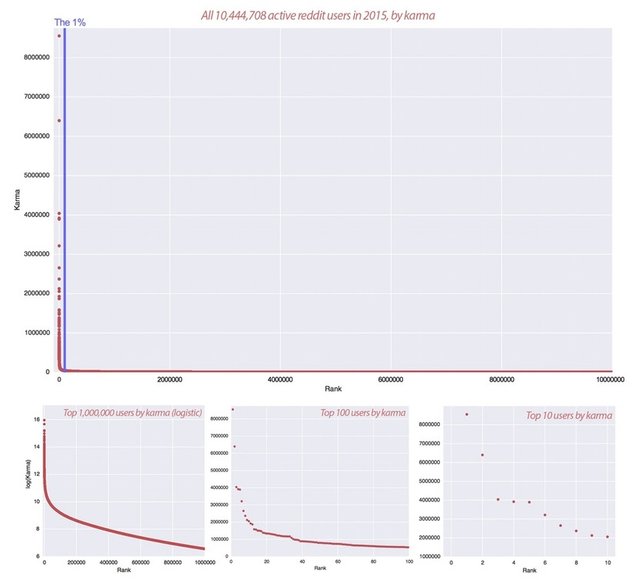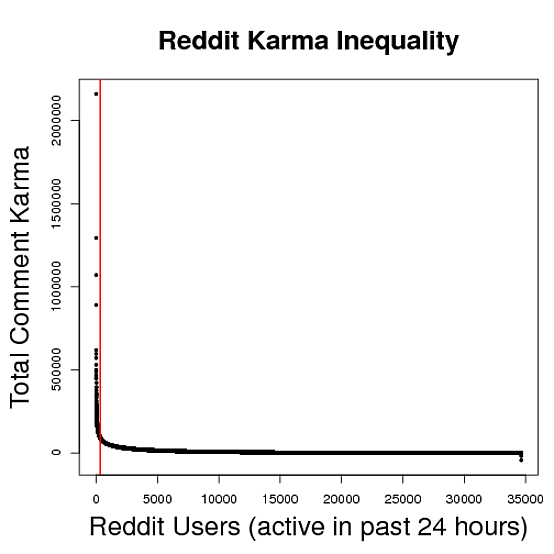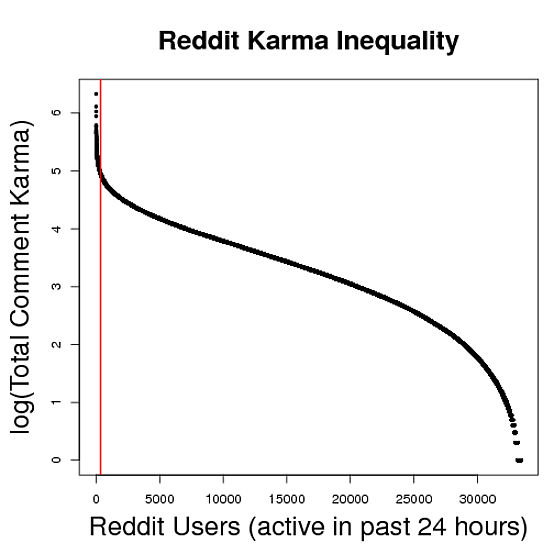Blog rewards CAN’T be widely distributed
This is my analysis of the design constraints I have concluded the designers of Steem faced w.r.t. the author reward algorithm(s). I am not covering the curation rewards in this post, except for a brief mention w.r.t. whales.
Note this derives entirely from my own thought process and I’m not privy to any discussions the developers may have had, except for what is in the white paper and what I’ve read on Steemit, e.g. @theoretical’s blogs. So I might possibly have mistakes. If anyone can find any errors in my thought process, please offer your ideas and corrections in the comments section.
Even if this post makes you sad, you might consider to still respect my research and effort. Lying to ourselves won’t help us achieve our goals of transforming the world to a better place. I remain devoted to striving to reach those ideals.
Trade-offs of Available Design Options
Steem computes how the votes divide the pot of money for author rewards.
- Weighting each vote equally, i.e. linear weighting, would enable at least two egregious vulnerabilities:
- Voters could vote for their own posts as the maximum profit strategy because the imparted reward per voter is not tied to any risk of popularity, so those who vote their conscience would eventually over time have their wealth redistributed via debasement to those who always voted for themselves.
- The ban on transferring STEEM POWER could be subverted by voting on whom you wanted to transfer to, without any risk of loss of (proportional) value (in the money supply). This would enable consolidating free signup balances to meet the theshold for powering down without earning any rewards from blogging. Fake Facebook accounts can be obtained for pennies and even for free if they are resold after employing them to signup free Steem accounts. So attackers could drain the 40% (i.e. ~$80 million) of the Steem money supply that is earmarked for free signup rewards.
- Weighting each vote according to its share of the square of the total number of votes on each blog post, i.e. quadratic weighting, nullifies the vulnerabilities from #1 if each blog can’t be sure to receive a sufficient¹ share of the total vote, but it enables at least two (arguably tolerable) vulnerabilities:
- A maximum profit strategy for the case where sufficient voters are able join together in a pact to upvote each other’s blog posts so these blogs receive a sufficient¹ share of the total vote. For example, an attacker’s legion of free signup accounts (a.k.a. the result of a Sybil attack on free signups).
- The existence of whales make it unlikely for pacts of the lesser fish to achieve that sufficient¹ share of the total vote.
Steem Chose Whales With Quadratic Weighting
Steem appears to have had no choice but to choose #2 and accept that the existence of whales is absolutely necessary to nullify the other vulnerabilities which lead to degenerate outcomes. But the necessary existence of whales is in itself a (perhaps tolerable) degenerate outcome.
Deviant whales could maximize profit by voting for their own or blog posts that provide kickbacks, because a whale’s vote has such a great influence on the total vote of a blog post both in terms of the whale’s vote power and the increased ranking visibility creating a vortex of upvotes. Although we assume whales are benevolent and motivated to protect the long-term value of Steem, at some future juncture some (perhaps new takeover investors) whales might instead see the mature Steem system as ripe for harvesting both by capturing maximum units of STEEM while also shorting the price to offset any decline due to their abusive activities.
Additionally for blogs that (and especially if whales vote them early) garnish sufficient¹ share of the total vote (which they normally do with regularity), then whales’ share of the money supply can be always increasing (not counting the free signup air drops), i.e. the GINI coeficient can worsen. Note the curation reward algorithms are complex and not fully documented, so perhaps something was done to minimize this effect.
Which Means Rewards CAN’T be widely distributed
But another ramification is that whales can’t dilute their votes too much else they open the vulnerability for pacts to form to enable the first vulnerability in #2. Thus blog rewards CAN’T be widely distributed both for that reason and simply because it is too much cognitive load on the whales to be the deciders for millions of blog posts in a diverse ecosystem of preferences.
Onboarding is the Goal
My understanding from the white paper is that rewards were not intended to be the supreme feature for Steem. It is an onboarding marketing method, with bigger plans to come once the users are onboard. The exaggerated rewards for a fewer number of posts is stated in the white paper to be an advantage because it will cause users to overestimate their potential for earning on the site, i.e. it will cause excess enthusiasm.
The challenge for crypto-currencies has always been how to distribute them to the masses, so we can jump-start an ecosystem that includes more than just male cryptonerds. Steem is offering its imperfect onboarding paradigm and so far it is generating enthusiasm.
¹ By sufficient I mean that a vote is cast for a blog post which garnishes enough votes such that the imparted rewards weight of that casted vote is proportionally more than that vote’s proportion of the total systemic voting power. It is easiest to understand with a simple example. Imagine we have only 101 voters each with 1 unit of voting power in Steem, so each voter has 1/101th of total voting power. If 100 of the voters vote in groups of 10 each on 10 different blog posts, and the remaining voter is the sole voter on a blog post, then each of the 10 impart the square 10 × 10 = 100 rewards for a total of 1000 rewards, and the remaining voter only 1 × 1 = 1 reward. So the sole voter has 1/1001 of the total rewards, but the each of the other voters has 1/10th of 100/1001 rewards (i.e. 10/1001) which is 10 times greater. So we can say all but the sole voter participated in sufficient vote totals in order to receive outsized rewards compared to their proportion of the systemic voting power. The more egregious example would be if all of the voters each voted alone on a separate blog post, except for 10 of the voters that formed a pact to vote on a single blog post. So the pact of 10 would impart 100 times greater rewards (i.e. 10 times greater per voter) to the blog post’s author as compared to other voters.

The blogging platform is a Trojan Horse (Dan's term, never forget that)... basically a device to bootstrap something infinitely more valuable = a fast currency that can handle microtx on a general purpose platform.
https://steemit.com/steem/@dan/steemit-s-evil-plan-for-cryptocurrency-world-domination
In terms of the blogging rewards, it's meant to replace Google ad revenue that drives professional blogging. So any discussion that ignores how random whale upvoting will replace Google ad payments to professional writers misses the point.
This may be a harsh reality for some, but the world is not crying out for more 22 yo amateur bloggers.
Note that dilemma predicted by my 2016 blog is happening.
Vitalik wrote an excellent blog on the game theory of Collusion which is relevant to this blog of mine.
I had seen allusions to Dan's use of that term. Haha, I think he got that subconsciously from me, as I had so often referred to Bitcoin as a Trojan Horse of the DEEP STATE since 2013, and he has turned it around to have a positive meaning. I am just joking about him getting it from me, but I was known to be the one heavily using that term at Bitcointalk.
Of course most of us understand the motivation to move away from spamming ourselves with ads.
And the greater incentive for mankind is to stop the sort of censorship and theft of followers that the behemoth social networks are doing (see my comment reply to @spookypooky below).
As for professional bloggers, I think it is all about building community and monetizing the community. Ads are a form of that but they have low relevance which is why we find them spammy.
Thus intuitively I don't expect a globalized monetization to be conceptually correct. One of the differences between the design instincts of Dan and myself, has always been that I am looking for degrees-of-freedom and (at least in the past) he was trying to design in some globalized interest rate and collectivized monetary aspects. This was one of the key differences I observed between our thought processes when he and I used to discuss before he left Bitcointalk for his Bitshare forum. However, I also see he has innovated in ways that are insightful. I am thinking the globalized debasement can be used with some localized community degree-of-freedom, but I haven't yet worked out exactly how to do this. I am still in analysis mode.
Btw, this system is a tremendous accomplishment. A lot of development effort in this and an ecosystem with a lot of people contributing. Kudos.
This experiment is providing much data and a testbed for increasing our understanding; and is causing a lot of brainstorming in our cryptocommunity.
Edit: note I have replied to Dan's latest blog proposal.
This is a very insightful piece and a quality discussion as erupted. We are well aware of the limits of the system and are actively working toward a solution that could completely revolutionize the effectiveness of award distribution while mitigating the impacts of misbehaving whales.
Apologies I didn't immediately see your comment. Ah I had just finished commenting that I was pleasantly surprised that you upvoted my blog post. I didn't expect any whale to upvote it.
It is great that you are open to constructive criticism. And that you recognize the value of the blog posts which erupt into discussion, because I believe the highest valued content are those that increase engagement and foment sub-communities.
My blog post is also trying to help people understand that the options available for the design are difficult. It is not any diabolical master plan. Since you and I used to debate long ago in 2013 at Bitcointalk.org, you've been trying to find a way to onboard the masses to crypto-currency. Now you have something which is sort of working and has made a big splash, but there are still big challenges remaining in order to make this scale and diversify out.
I am very active in thinking about possible design improvements and tweaks, as I am sure are all of you who are already developers for the Steem ecosystem.
Here are my old thoughts on "fair" cryptocurrency distribution.
As I see it the major issue we'll have to face is not reward distribution (that can probably be fixed with hard-caps per post in order to force the rest of the small-medium rewards to increase) but long-term reward scaling.
-The user base is 50.000. When it goes to 50 million, it will be 1000x.
-The marketcap is 200mn. To keep the rewards "consistent", we'll have to experience a 1000x growth in the marketcap to reach 200 BILLION (bitcoin in comparison is 10bn).
In other words, the userbase can experience booming growth yet the reward pool cannot (in all probability). Which means the avg reward will go down a lot, and that's when the other attributes of the platform, like censorship-resistance, instead of "rewards" must come into play as a motive to participate.
I've made the analogy that early posters are like "early miners" of cryptocurrency, precisely due to the above issue of problematic reward scaling as the userbase increases: https://steemit.com/opportunity/@alexgr/contemplate-this-if-blogging-mining-then-early-blogger-early-miner
...but obviously this can't last for a long time without changes to the economic model or some kind of other tweaks to the economy, money infusion from outside our closed loop, etc etc. I guess we'll see what the devs have in mind for this...
No afaics, that would just open the vulnerability for pacts. Once you lower the threshold for sufficient¹ (see blog post), then you've reduced the protection against them.
Agreed on your other points, except I do think the market cap for a social network that somehow creates a new token ecosystem could be much higher than Facebook and perhaps even into the $trillions if the right confluence of factors comes about (e.g. the world realizes the negative profit future of the industrial age economy and wealth moves to the knowledge creation age economy), but that is a long shot so I will concede to your concern.
If, say, you have a 1000$ or even 500$ limit, I don't see right now how small votes can accumulate to that level. I have ~3500$ in SP and my vote is worth 2 cents. It would take A LOT of money to start hitting the limits.
You are forgetting the effect of the quadratic weighting. Refer again to footnote ¹ in the blog post. The amount of reward is the proportion of the total pot of reward. So if the pact reaches the sufficient level explained in footnote ¹, then the reward is outsized. Ditto curation rewards (I think).
The problem with Steem's voting reward algorithm is not that 20% get 80% of the rewards, but it is that the selection of the 20% is done by 1%. And this is motivating the wrong behaviors and focus of content produced.
Some part of the difference is the drop in market value. My votes aren't worth what they used to be worth either.
I don't think it is really the algorithm as much as the distribution. With 50% of the daily-active stake controlled by 1-2%, no matter what algorithm you use, the 1-2% is going to run the show. Nothing can really change until the stake is spread out.
If curation rewards weighted exponentially more the earlier you vote as I heard they are (and especially if they are 3 - 5 times author rewards as claimed by @james-show in the comments here), then @dantheman's $140 in author rewards could be good for perhaps an order-of-magnitude higher in curation rewards. I know you were thinking about thresholding author rewards, but if curation rewards are more lucrative for pacts, then you'd need threshold them also.
Also I don't believe @dantheman's upvote is only $140. That is probably because his voting power was diluted by numerous upvotes. I've observed @smooth upvote my post and it jumps several $100s or more when he hasn't been too busy voting recently. @ned upvoted my first blog after my #introduceyourself post and I think it was like instant ~$1000 boost.
Even if you threshold at $500, it won't solve the problem. You will still have a minority of the posts at $500 and the vast majority at a few dollars. The top tail of the power-law distribution is very steep, so not many posts above $500 any way.
You'll need to bring the threshold down to much less than $100 per blog post to really spread out the rewards widely and then you will open the vulnerability to pacts.
Remember my calculation from our discussion at BCT:
Also I assume naturally income and blog quality is going to power-law distributed as well in any case, so we won't be able to widely distribute rewards in any case. The only way to widely distribute money is to make a few people very rich and the 85% get the crumbs. This is unfortunately the natural power-law distribution of wealth that always exists in every instance of humanity. I guess we can argue the distribution in Steem is even more concentrated (worse) than a natural power-law distribution. So maybe you are advocating thresholds to try to get closer to a natural power-law case, but the problem is the vulnerability comes into play and we are starting from a worse than power-law distribution due to the way the Steem token was launched. So afaics we'd have to compensate with a very low threshold.
Obviously, but still it takes quite a lot... I mean dantheman has ~3mn $ in SP and his upvote is like 140$.
Agreed.
Thanks for raising the point of clarification because no one can read my mind. In my mind I was thinking of selection algorithm in a more general sense of for example not allowing whales to vote (which I posited in this blog would be game theoretically vulnerable to attack) or not even using voting to select rewards. I haven't yet proposed any concrete ideas for a better algorithm for selecting rewards.
Note I am positing in this blog that spreading the stake out will be vulnerable to attack by collusion of voters.
@Anonymint, did you say only the top 1% decides who can be in the top 20% in Steem, to be the top whales? Are you saying that will always be the case? I was thinking that some people can become whales if they are popular enough to get upvotes each day by thousands or maybe someday by millions of people each day over the course of maybe many years and not just upvotes by bots.
Like I have been saying in previous comments, I want to believe that some people can slowly get into the top 20 percent. Are you saying that the top 1 percent will downvote potential whales if the top one percent decided to do so or something? And if the top one percent has that kind of power, then the question is whether or not the top one percent should have that much power over what might be basically their own FrankenSteem Creation, right?
Mathematically it would require dissension at the top and unanimity at the bottom w.r.t. to upvoting, which seems highly implausible.
Thanks for the response. Interesting. Upvoted.
I suspect the distribution of SP on Steemit will be comparable to Karma on Reddit. In 2015, the top 1% of Reddit users had 47% of the total Karma. If you can't see the following photo in detail, click this photo link: http://imgur.com/cfWa4Ty

In an older data set, the top 1% of users had about 20% of the Comment Karma (different from Total Karma):

Logarithmic Scale:

In this logarithmic graph, each number on the y axis is 10x the previous number:
1 = 10
2 = 100
3 = 1000
4 = 10000
5 = 100000
6 = 1000000
The problem with Steem's voting reward algorithm is not that 20% get 80% of the rewards, but it is that the selection of the 20% is done by 1%. And this is motivating the wrong behaviors and focus of content produced.
Also, you present a false dilemma: the notion that votes must be weighted linearly (or quadratically, however that works) , or not at all (1-man-1-vote.). And just as a side note, ive never heard anyone actually say that it ought to be one man one vote.
There are actually many models that could provide some normalization, while still giving regular voters some effect on ultimate outcome.
For example, the quadratic mean that i talked about above, or RMS, which i kind of feel like your post is implying we use now, even though im pretty sure we don't. I actually wrote a post about how something like that would help the rewards proccess, but ultimately decided why bother.
I replied to your other comment on this page. And that is enough already.
thanks, but i really don't need you to tell me when i can and can't post.
I meant that is enough for me replying to you already. Of course I can't control what you do. Thanks.
Tl;dr Join for the money, stay for the community.
I like that.
And for the censorship resistant storage of content on a blockchain. See what the centralized social networks do. No one should own and control our effort to build a following and our production.
I appreciate posts like this where the real guts of Steem are questioned and broken-down. If there are short-comings in the algorithm, my hope is that through experimentation and iteration, either improvements can be made here or similar competing platforms can come around and offer a slightly different -- and possibly better -- option.
I am impressed that @dantheman upvoted this blog post. I presume that is also @dan's account. I expected that no whale would upvote this blog post.
https://steemit.com/steemit/@chitty/whale-s-dilemma#@anonymint/re-chitty-whale-s-dilemma-20160812t194021874z
Sorry I believe the bolded is an impossible option.
The only way would be to change from voting out of a shared pool of debasement to tipping from individual wallets, which is not a viable model.
Sorry IMO Steem is stuck between a rock and a hard place.
And the rich are now growing richer on Steem.
I might be way stupid here, but doesn't curation rewards being order of magnitude (or at least 3-5 times) bigger than the blogging rewards solve all the issues?
Can you expand a bit on that?
The white paper says curation rewards are 3.875% same as for author rewards. I heard the white paper needs to be rewritten because some major changes have occurred hence.
I didn't know that curation rewards are that high. I haven't really thought about how making them high would impact my thought process. But off the top of my head, it seems to me the same issues that apply to author rewards and the potential for pacts forming also applies to curation rewards. How do you see it mitigating the vulnerabilities I presented?
It seems to me curation rewards make it worse, because the minions have an extra incentive to vote with the whales.
Curation rewards are a maximum of 1/3 of the size of content rewards, but reduced from that maximum by votes in the first 30 minutes. The white paper has a lot of details like that wrong.
Is the full 7.75% (or the 10% yearly money supply created) allocated for author rewards and then up to 1/3 taken from that? That matters for my computation of the debasement rates. I am preparing to write Part 2 of my blog on that, so having the correct figures would be helpful.
2 STEEM per block are allocated to the reward fund. 75% of the reward fund is allocated for content and up to 25% for curation. There are floor percentages that kick in once the supply gets large enough and I think the numbers in the white paper for those are still correct.